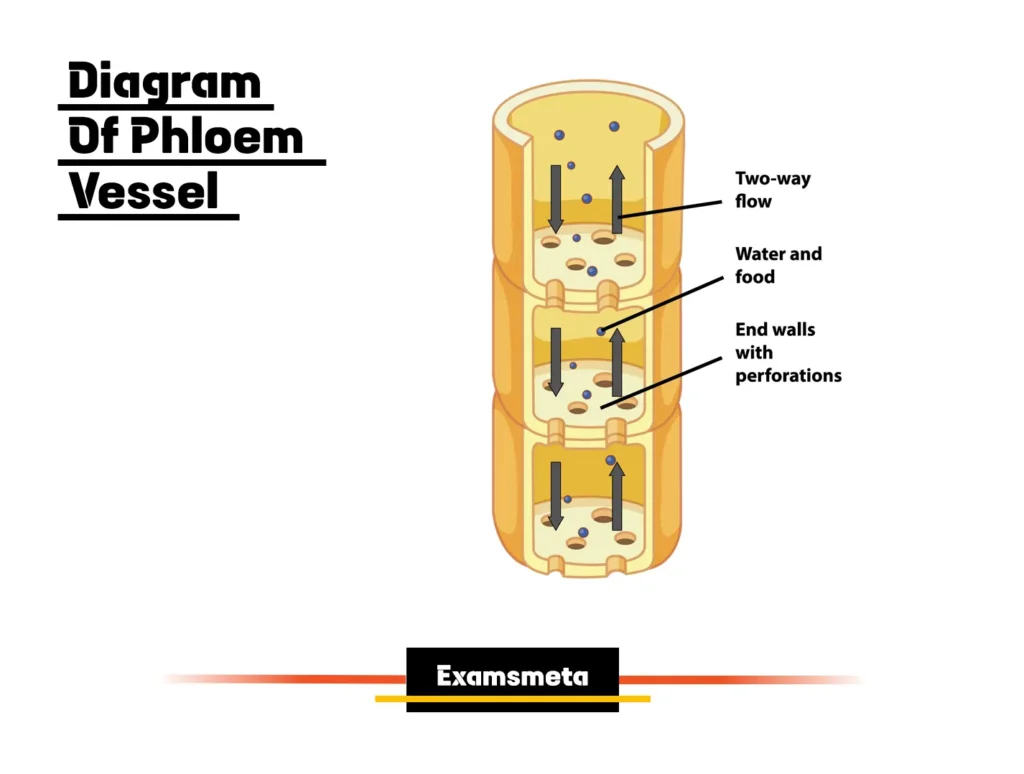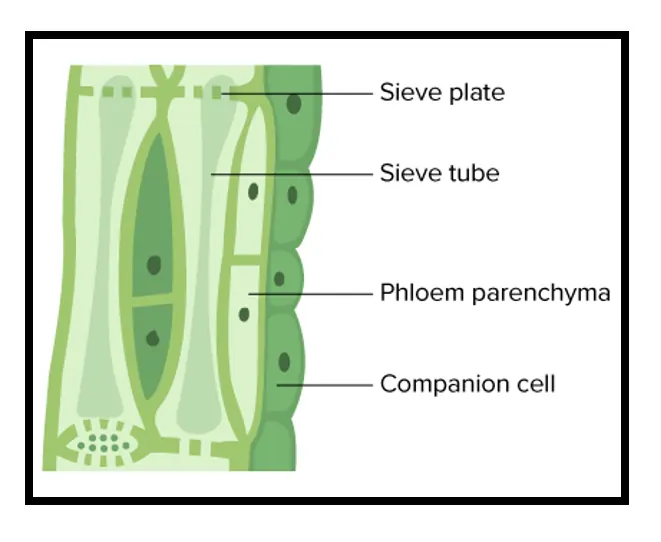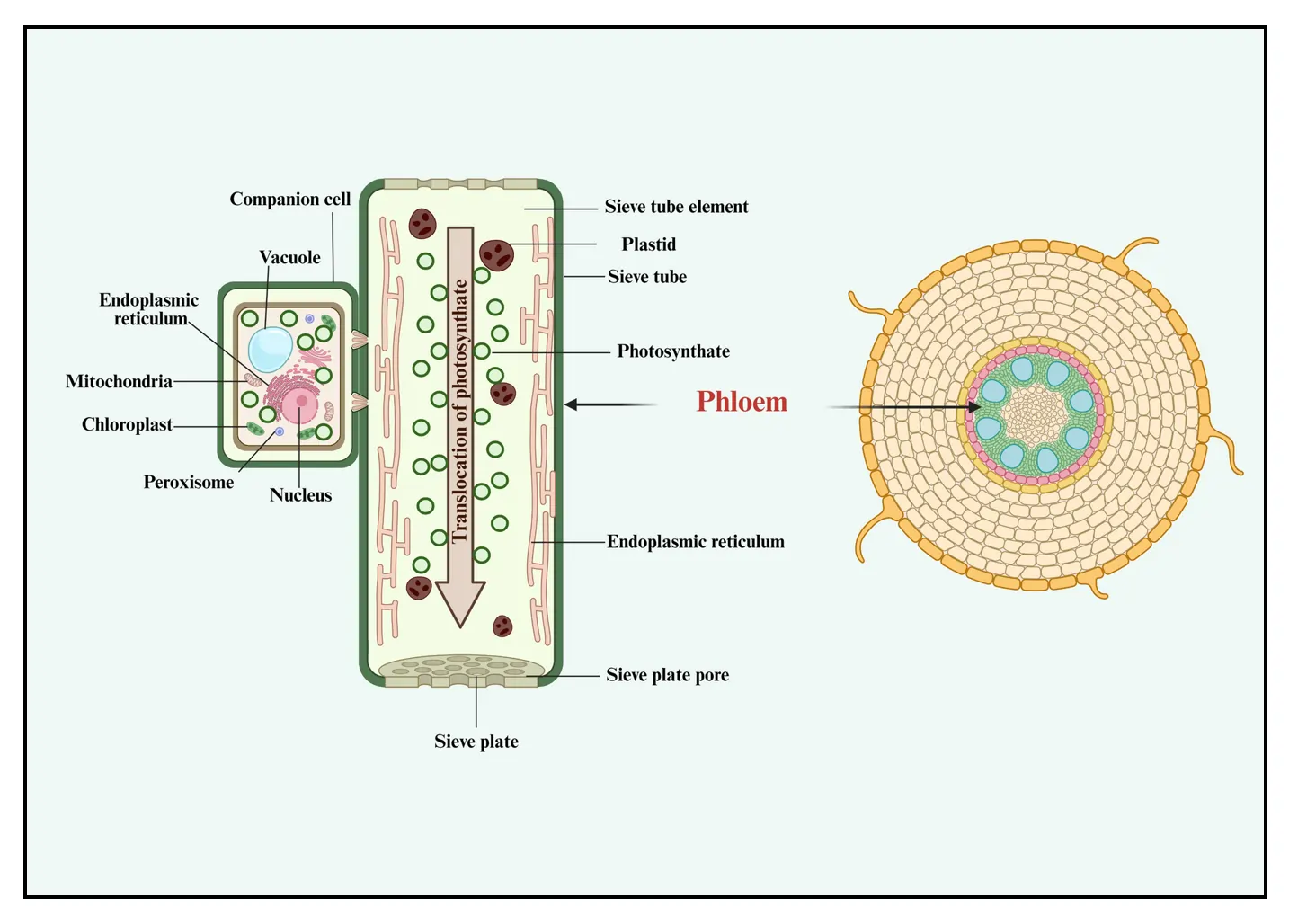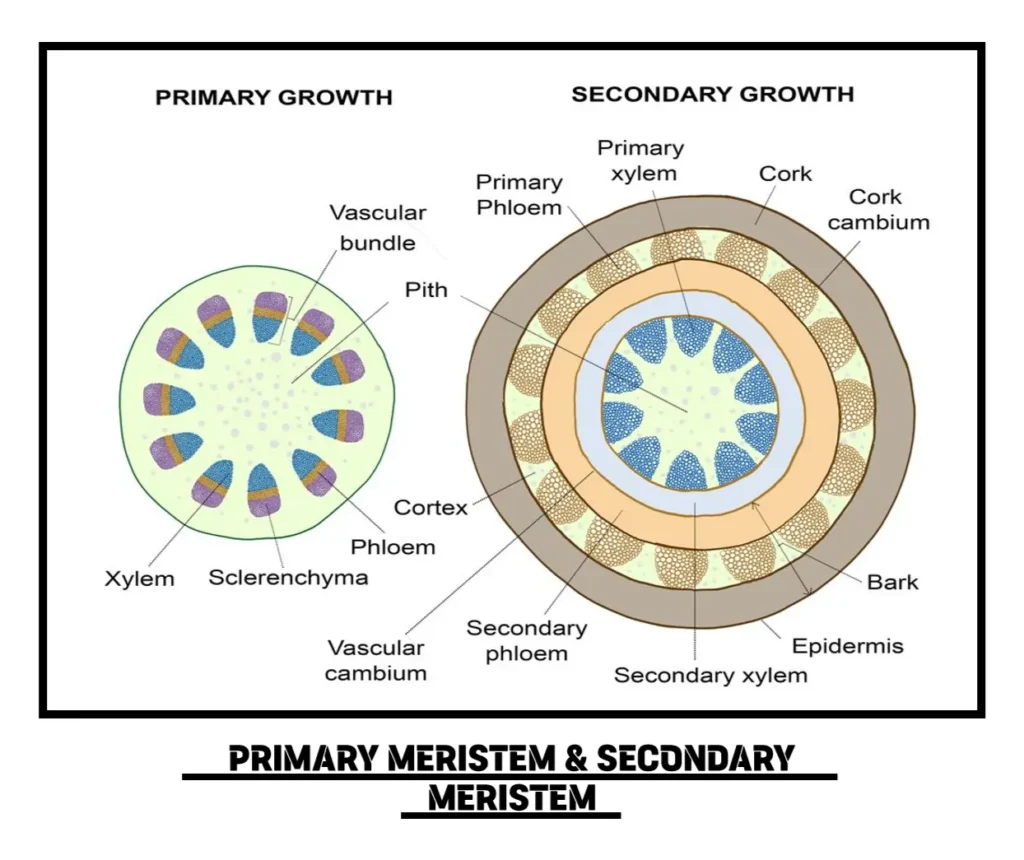The vascular system of plants is a marvel of biological engineering, enabling them to thrive in diverse environments. Among its components, phloem stands out as the primary conduit for transporting the products of photosynthesis, ensuring that energy-rich compounds reach every part of the plant. Unlike xylem, which conducts water and provides structural support, phloem is dedicated to the movement of organic nutrients, such as sucrose, amino acids, and signaling molecules.
This article delves into the structure, cellular components, types, functions, and significance of phloem, enriched with insights from reputable sources and additional details to provide a comprehensive understanding of this vital tissue.
Table of Contents
What is Phloem?
Phloem is a complex, living vascular tissue responsible for translocation, the process of moving photosynthetic products—primarily sucrose—from source tissues (like leaves) to sink tissues (such as roots, fruits, and growing regions). This nutrient transport is essential for plant growth, reproduction, and storage. Phloem is found in the vascular bundles of plants, typically located on the outer side, closer to the plant’s surface, in contrast to xylem, which lies deeper within. The bidirectional flow of materials in phloem distinguishes it from the unidirectional flow of water in xylem. Its role extends beyond mere transport, as it also facilitates signal transmission and supports storage functions, making it indispensable for plant survival.

Cellular Components of Phloem
Phloem is a heterogeneous tissue composed of specialized cell types, each contributing to its functionality. These cells work in concert to ensure efficient nutrient transport and structural integrity. Below is a detailed exploration of the key cellular components of phloem:

- Sieve Tube Elements: In angiosperms, these are the primary conducting cells, forming long, continuous sieve tubes. Sieve tube elements are elongated, living cells that lose their nucleus and most organelles at maturity, relying on companion cells for metabolic support. Their end walls, known as sieve plates, contain perforations (sieve pores) that allow the flow of nutrients. The absence of a nucleus reduces metabolic demands, optimizing the cells for transport.
- Companion Cells: These specialized parenchyma cells are closely associated with sieve tube elements, connected via plasmodesmata (cytoplasmic channels). Companion cells possess a nucleus and dense cytoplasm, enabling them to regulate the metabolic activities of sieve tubes. They play a critical role in loading and unloading sugars into the sieve tubes, a process driven by active transport mechanisms that create a pressure gradient for nutrient flow.
- Phloem Parenchyma: These living cells are involved in storage and the lateral movement of materials within the phloem. They store starches, lipids, and other nutrients, which can be mobilized during periods of high demand, such as during fruit or seed development. In some plants, phloem parenchyma also aids in wound healing by forming callus tissue.
- Phloem Fibers: Unlike other phloem cells, these are dead, lignified cells that provide limited structural support. They are larger than xylem fibers and are typically found on the outer edges of vascular bundles. While their primary role is structural, they contribute minimally compared to xylem fibers.
- Sieve Cells: Found in gymnosperms, sieve cells serve a similar function to sieve tube elements but are less specialized. They lack sieve plates and instead have sieve areas—regions with numerous pores for nutrient transport. Sieve cells are associated with albuminous cells, which perform a role analogous to companion cells in angiosperms.

| Cell Type | Function | Living/Dead | Presence |
|---|---|---|---|
| Sieve Tube Elements | Conduct nutrients in angiosperms | Living | Angiosperms |
| Companion Cells | Regulate sieve tube activity | Living | Angiosperms |
| Phloem Parenchyma | Store nutrients, aid lateral transport | Living | Angiosperms, Gymnosperms |
| Phloem Fibers | Provide structural support | Dead | Angiosperms, Gymnosperms |
| Sieve Cells | Conduct nutrients in gymnosperms | Living | Gymnosperms |
Types of Phloem
Phloem is classified based on its developmental origin, reflecting the dynamic nature of plant growth. The two main types are primary phloem and secondary phloem, each with distinct characteristics and roles.
- Primary Phloem: Originating from the apical meristem (the growing tip of stems and roots), primary phloem is formed during the early stages of plant development. It consists of two subtypes:
- Protophloem: The first-formed phloem, protophloem, is often temporary and becomes crushed or non-functional as the plant grows and expands.
- Metaphloem: The mature, functional primary phloem that persists longer and supports nutrient transport in young plant tissues.
- Secondary Phloem: In plants exhibiting secondary growth (e.g., woody plants), secondary phloem is produced by the vascular cambium, a layer of meristematic tissue. Secondary phloem is continuously formed and replaced as the plant grows, ensuring a steady supply of functional tissue. Older secondary phloem is pushed outward and may become part of the bark, while newer layers take over transport functions.

The distinction between primary and secondary phloem is particularly evident in dicots and gymnosperms, where secondary growth is common. In contrast, monocots, which lack a vascular cambium, rely solely on primary phloem throughout their life cycle.
Functions of Phloem
The phloem is a multitasking tissue, performing several critical roles that sustain plant growth and development. Its functions can be broadly categorized as follows:
- Nutrient Transport (Translocation): The primary function of phloem is to transport organic compounds, such as sucrose, amino acids, and other metabolites, from source tissues (where Westbrook where they are produced, typically leaves) to sink tissues (where they are used or stored, such as roots, fruits, and growing shoots). This process, known as translocation, is driven by a pressure-flow mechanism. Sugars are actively loaded into sieve tubes at the source, creating a high-pressure zone that pushes the nutrient-rich sap toward sink tissues, where sugars are unloaded for use or storage.
- Signal Transmission: Phloem serves as a communication highway, transporting signaling molecules like hormones (e.g., auxins, gibberellins) and RNA molecules that regulate plant growth, development, and responses to environmental stimuli. For example, phloem-transported signals can trigger flowering or activate defenses against pathogens.
- Storage Support: Phloem parenchyma cells act as storage reservoirs for starches, proteins, and other nutrients. These reserves can be mobilized during periods of high demand, such as during seed germination, fruit ripening, or recovery from stress. In some plants, such as sugar beets, phloem parenchyma stores significant amounts of sucrose.
- Defense Mechanisms: Phloem contributes to plant defense by transporting secondary metabolites, such as alkaloids and phenolics, which deter herbivores and pathogens. Additionally, when damaged, phloem can initiate callose deposition—a rapid sealing mechanism that blocks sieve pores to prevent nutrient loss and pathogen entry.
| Function | Description | Example |
|---|---|---|
| Nutrient Transport | Moves sucrose and other compounds from source to sink tissues | Sucrose transport from leaves to fruits |
| Signal Transmission | Transports hormones and RNA for growth and environmental response | Auxin movement to regulate growth |
| Storage Support | Stores starches and nutrients for later use | Starch storage in phloem parenchyma |
| Defense Mechanisms | Transports defensive compounds and seals wounds via callose | Callose deposition in response to injury |
Structural Characteristics of Phloem
The structure of phloem is intricately designed to optimize nutrient transport. Sieve tubes are the backbone of this system, characterized by their elongated, thin-walled structure and sieve plates, which contain pores (typically 0.1–10 micrometers in diameter) that facilitate the flow of sap. The living nature of phloem (except for phloem fibers) allows it to actively regulate transport and respond to environmental changes. Unlike xylem, which is rigid and lignified, phloem is flexible, enabling it to function in growing tissues without breaking.
Phloem is strategically positioned in the vascular bundles, typically on the outer side in stems and roots, making it more vulnerable to damage from herbivores or mechanical injury. In monocots, phloem is scattered throughout the vascular tissue, while in dicots, it is organized in distinct bundles. The bidirectional flow of nutrients in phloem allows plants to distribute resources efficiently, adapting to changing demands in different tissues.
The Pressure-Flow Hypothesis
The mechanism of nutrient transport in phloem, known as the pressure-flow hypothesis, is a cornerstone of plant physiology. This model explains how phloem sap moves from source to sink:
- Sugar Loading: At the source (e.g., leaves), companion cells actively transport sucrose into sieve tubes using proton pumps and co-transporters. This creates a high concentration of sugars, lowering the water potential in the sieve tubes.
- Water Influx: The low water potential draws water from adjacent xylem vessels into the sieve tubes via osmosis, increasing the turgor pressure in the source region.
- Pressure Gradient: The high turgor pressure at the source pushes the phloem sap through the sieve tubes toward the sink, where sugars are unloaded.
- Sugar Unloading: At the sink (e.g., roots or fruits), sugars are actively or passively removed from the sieve tubes, reducing the sugar concentration and allowing water to exit back into the xylem.
- Recycling Water: The movement of water back to the xylem maintains the pressure gradient, ensuring continuous flow.
This mechanism is highly efficient, allowing plants to transport nutrients over long distances, sometimes exceeding hundreds of meters in tall trees like redwoods. However, it is energy-intensive, as companion cells require ATP to drive active transport.
Phloem in Different Plant Types
Phloem structure and function vary across plant groups, reflecting their evolutionary adaptations:
- Angiosperms: These plants have highly specialized sieve tube elements and companion cells, enabling efficient nutrient transport. The presence of sieve plates enhances the speed and volume of sap flow, supporting the rapid growth and reproduction typical of angiosperms.
- Gymnosperms: Lacking sieve plates, gymnosperms rely on sieve cells and albuminous cells for nutrient transport. While less efficient than angiosperm phloem, this system is sufficient for their slower growth rates and woody structures.
- Monocots vs. Dicots: In monocots, phloem is scattered in vascular bundles, providing flexibility in herbaceous stems. In dicots, phloem is organized in a ring, facilitating secondary growth and the formation of bark in woody plants.
Phloem and Plant Adaptations
Phloem plays a critical role in plant adaptations to environmental challenges. For example:
- Drought Resistance: In drought-tolerant plants, phloem parenchyma stores water and nutrients, acting as a buffer during water scarcity.
- Seasonal Storage: In deciduous trees, phloem stores carbohydrates in late summer, which are mobilized in spring to support new growth.
- Pathogen Defense: Phloem transports defensive compounds and triggers systemic acquired resistance, where signals from an infected area activate defenses throughout the plant.
Phloem in Agriculture and Research
Understanding phloem is crucial for agriculture and plant biology research. For instance:
- Crop Yield: Enhancing phloem transport efficiency can increase sugar delivery to fruits and seeds, boosting crop yields. Genetic modifications targeting companion cell function have shown promise in improving translocation.
- Pest Management: Many pests, such as aphids, target phloem to feed on nutrient-rich sap. Studying phloem defenses can lead to strategies for pest control, such as breeding plants with enhanced callose deposition.
- Biotechnology: Phloem’s role in signal transmission makes it a target for genetic engineering to improve plant responses to stress, such as drought or salinity.
Challenges and Vulnerabilities
Phloem’s living nature makes it susceptible to damage and disease. Phloem necrosis, caused by pathogens like phytoplasmas, can disrupt nutrient transport, leading to plant decline. Mechanical injuries, such as cuts or herbivore feeding, can trigger callose deposition to seal damaged areas, but excessive damage may impair phloem function. Additionally, environmental stresses like extreme temperatures can affect the viscosity of phloem sap, slowing translocation.
Conclusion
Phloem is a dynamic and essential tissue that sustains plant growth by transporting nutrients, signaling molecules, and defensive compounds. Its intricate structure, comprising sieve tube elements, companion cells, phloem parenchyma, and phloem fibers, is finely tuned for efficient translocation. From supporting fruit development to enabling long-distance communication, phloem is a cornerstone of plant physiology. By understanding its structure and functions, researchers and farmers can unlock new ways to enhance plant productivity and resilience, ensuring a sustainable future for agriculture.
Acknowledgements
The creation of the article “Phloem: A Comprehensive Overview to the Lifeblood of Plant Nutrient Transport” was made possible through the wealth of information provided by numerous reputable online resources. These sources offered detailed insights into the structure, function, and significance of phloem in plant physiology, ensuring the article’s accuracy and depth.
The Examsmeta deeply expresses its gratitude to the following websites for their valuable contributions:
- Nature (https://www.nature.com) for its comprehensive research articles on plant vascular systems.
- ScienceDirect (https://www.sciencedirect.com) for peer-reviewed studies on phloem transport mechanisms.
- Britannica (https://www.britannica.com) for foundational knowledge on plant anatomy.
- PLOS Biology (https://journals.plos.org/plosbiology) for insights into phloem signaling pathways.
- Frontiers in Plant Science (https://www.frontiersin.org) for detailed analyses of phloem cell types.
- American Society of Plant Biologists (https://aspb.org) for educational resources on plant physiology.
- Khan Academy (https://www.khanacademy.org) for clear explanations of the pressure-flow hypothesis.
- Royal Society Publishing (https://royalsocietypublishing.org) for studies on secondary phloem development.
- Plant Physiology (https://www.plantphysiol.org) for in-depth research on translocation processes.
- New Phytologist (https://nph.onlinelibrary.wiley.com) for information on phloem adaptations in diverse plant species.
- Botanical Society of America (https://www.botany.org) for resources on vascular tissue evolution.
- Oxford Academic (https://academic.oup.com) for scholarly articles on the phloem’s role in plant defense.
- Springer (https://www.springer.com) for publications on phloem structure in angiosperms and gymnosperms.
- BioMed Central (https://www.biomedcentral.com) for open-access research on phloem parenchyma functions.
- Wiley Online Library (https://onlinelibrary.wiley.com) for studies on the phloem’s agricultural significance.
Related Articles
- Meristematic Tissues in Plant Growth: A Detailed Exploration
- Characteristics of Meristematic Tissues: The Powerhouse of Plant Growth
- Classification of Meristematic Tissues: The Architects of Plant Growth
- Permanent Tissues in Plants: A Comprehensive Guide
- Simple Permanent Tissues: The Foundation of Plant Anatomy
- Complex Permanent Tissues: The Vascular Lifelines of Plants
- Complexity of Xylem and Phloem: The Lifelines of Plant Transport Systems
- Xylem: The Lifeline of Plant Water Transport and Structural Support
- Phloem: A Comprehensive Overview of the Lifeblood of Plant Nutrient Transport
- Epidermal Tissue System in Plants: A Comprehensive Exploration
- Monocot and Dicot Roots: Structure, Function, and Differences
- Monocot and Dicot Stems: Structure, Characteristics, and Examples
- Dorsiventral Leaf: A Comprehensive Exploration of Structure and Function
- Isobilateral Leaf: A Comprehensive Exploration of Structure, Features, and Comparisons
- Secondary Growth in Plants: A Comprehensive Exploration
- Cork Cambium: The Architect of Plant Protection and Growth
Frequently Asked Questions (FAQs)
FAQ 1: What is phloem, and what is its primary function in plants?
Phloem is a vital vascular tissue in plants responsible for translocation, the process of transporting photosynthetic products, primarily sucrose, from source tissues (such as leaves where photosynthesis occurs) to sink tissues (like roots, fruits, and growing regions). Unlike xylem, which moves water and provides structural support, phloem focuses on distributing energy-rich compounds to fuel growth, reproduction, and storage. This bidirectional transport system ensures that nutrients reach all parts of the plant, supporting metabolic processes and enabling plants to thrive in diverse environments.
The primary function of phloem, translocation, operates via the pressure-flow hypothesis, where sugars are actively loaded into sieve tubes at the source, creating a high-pressure gradient that drives nutrient-rich sap toward sinks. For example, in a tomato plant, phloem transports sucrose from leaves to developing fruits, ensuring they grow and ripen. Beyond nutrient transport, phloem also facilitates signal transmission by carrying hormones and RNA molecules, and it supports storage through phloem parenchyma cells. These multifaceted roles make phloem indispensable for plant survival and productivity.
- Key Role: Transports sucrose, amino acids, and other organic compounds.
- Example: In sugar maple trees, phloem sap is tapped to produce maple syrup, showcasing its nutrient-rich nature.
- Additional Function: Phloem transmits signaling molecules like auxins to regulate growth, such as triggering flowering in response to environmental cues.
FAQ 2: What are the main cellular components of phloem?
Phloem is a complex tissue composed of specialized cell types, each with distinct roles that ensure efficient nutrient transport and structural integrity. These components include sieve tube elements, companion cells, phloem parenchyma, phloem fibers, and, in gymnosperms, sieve cells. Together, they form a dynamic system tailored for translocation and other functions like storage and defense.
- Sieve Tube Elements: Found in angiosperms, these elongated, living cells form sieve tubes and are the primary conduits for nutrient transport. They lack nuclei at maturity but have sieve plates with pores that allow sap flow. For instance, in sunflower stems, sieve tubes efficiently transport sugars to growing seeds.
- Companion Cells: These cells support sieve tube elements by regulating their metabolic activities. Connected via plasmodesmata, companion cells use active transport to load sugars into sieve tubes, as seen in potato plants where they facilitate starch storage in tubers.
- Phloem Parenchyma: These living cells store starches and other nutrients, aiding in lateral transport within the phloem. In sugar beets, phloem parenchyma stores significant sucrose reserves.
- Phloem Fibers: Dead, lignified cells that provide limited structural support, often found on the outer edges of vascular bundles in plants like flax.
- Sieve Cells: In gymnosperms like pines, these cells perform a similar role to sieve tube elements but have sieve areas instead of sieve plates, supported by albuminous cells.
This diverse cellular makeup ensures phloem’s functionality across plant species, from herbaceous annuals to towering trees.
FAQ 3: How does phloem differ from xylem in structure and function?
Phloem and xylem are both vascular tissues, but they differ significantly in structure and function, working together to sustain plant life. While xylem transports water and minerals unidirectionally from roots to shoots and provides mechanical support, phloem focuses on bidirectional nutrient transport and lacks significant structural roles.
Structurally, phloem is a living tissue (except for phloem fibers) composed of sieve tube elements, companion cells, and phloem parenchyma, designed for flexibility and active transport. For example, in oak trees, phloem’s thin-walled sieve tubes allow nutrient flow to growing buds. Xylem, in contrast, consists of dead, lignified cells like vessels and tracheids, which form rigid conduits for water, as seen in pine wood. Phloem is located on the outer side of vascular bundles, making it more vulnerable to damage, while xylem lies deeper within.
Functionally, phloem’s translocation process moves sucrose and signaling molecules, driven by a pressure gradient, as in grapevines where sugars are transported to ripening grapes. Xylem’s unidirectional flow supports water and mineral delivery, crucial for photosynthesis. These complementary roles ensure plants maintain both hydration and nutrition.
- Structural Difference: Phloem is flexible and living; xylem is rigid and mostly dead.
- Functional Difference: Phloem enables bidirectional nutrient flow; xylem supports unidirectional water transport.
- Example: In a cucumber plant, xylem delivers water to leaves, while phloem transports sugars to developing fruits.
FAQ 4: What is the pressure-flow hypothesis in phloem transport?
The pressure-flow hypothesis explains how phloem transports nutrients from source tissues to sink tissues through a pressure gradient. This mechanism is central to translocation, ensuring efficient delivery of sucrose and other organic compounds across the plant.
The process begins with sugar loading at the source, typically leaves, where companion cells use proton pumps to actively transport sucrose into sieve tubes. This increases sugar concentration, lowering the water potential and drawing water from adjacent xylem via osmosis, creating high turgor pressure. The pressure pushes the nutrient-rich sap through sieve tubes toward sinks, such as roots or fruits, where sugars are unloaded for use or storage. Water then exits back to the xylem, maintaining the gradient. For example, in apple trees, this mechanism transports sugars from leaves to developing apples, supporting fruit growth.
- Key Steps: Sugar loading, water influx, pressure-driven flow, sugar unloading, and water recycling.
- Energy Requirement: The process is energy-intensive, requiring ATP for active transport in companion cells.
- Example: In tall trees like sequoias, the pressure-flow mechanism enables nutrient transport over hundreds of meters.
This hypothesis, supported by research from Plant Physiology, highlights phloem’s efficiency in long-distance transport.
FAQ 5: What are the types of phloem and how do they form?
Phloem is classified into primary phloem and secondary phloem, based on its developmental origin, each playing distinct roles in plant growth. These types reflect the dynamic nature of phloem as plants develop from seedlings to mature structures.
- Primary Phloem: Derived from the apical meristem, primary phloem forms during early plant development. It includes protophloem, the first-formed, often temporary tissue that gets crushed as the plant grows, and metaphloem, the mature, functional phloem supporting young tissues. For example, in young bean plants, metaphloem transports nutrients to growing shoots.
- Secondary Phloem: Produced by the vascular cambium in plants with secondary growth, such as woody dicots and gymnosperms, secondary phloem is continuously formed and replaced. Older layers are pushed outward, becoming part of the bark, as seen in oak trees where new phloem layers support nutrient transport annually.
In monocots like corn, which lack vascular cambium, only primary phloem is present. The formation of secondary phloem in woody plants, as noted by New Phytologist, supports their longevity and structural complexity.
- Primary Phloem Role: Supports nutrient transport in young, non-woody plants.
- Secondary Phloem Role: Sustains transport in woody plants with continuous renewal.
- Example: In pine trees, secondary phloem forms part of the bark, protecting inner tissues while transporting nutrients.
FAQ 6: How does phloem contribute to plant defense?
Phloem plays a critical role in plant defense by transporting defensive compounds and facilitating rapid responses to threats. Its living nature allows it to actively participate in protecting the plant from herbivores, pathogens, and mechanical damage.
When phloem is damaged, such as by aphid feeding, it initiates callose deposition, a rapid sealing mechanism where callose, a polysaccharide, blocks sieve pores to prevent nutrient loss and pathogen entry. For example, in tobacco plants, callose deposition limits the spread of viral infections. Phloem also transports secondary metabolites like alkaloids and phenolics, which deter herbivores, as seen in milkweed, where toxic compounds are moved to leaves. Additionally, phloem carries signaling molecules that trigger systemic acquired resistance, enabling the plant to activate defenses across distant tissues, as documented by Oxford Academic.
- Defense Mechanism: Callose deposition seals damaged sieve tubes.
- Chemical Defense: Transports toxic compounds to deter herbivores.
- Example: In tomato plants, phloem-transported signals activate defenses against fungal pathogens.
FAQ 7: How does phloem function differ between angiosperms and gymnosperms?
Phloem structure and function vary between angiosperms and gymnosperms, reflecting their evolutionary adaptations. Angiosperms, like flowering plants, have highly specialized phloem, while gymnosperms, such as conifers, have a less efficient but sufficient system for their needs.
In angiosperms, phloem consists of sieve tube elements with sieve plates, enabling rapid and voluminous sap flow, supported by companion cells. This efficiency supports fast growth and reproduction, as seen in sunflowers where phloem transports sugars to seeds. In gymnosperms, phloem relies on sieve cells with sieve areas, which are less specialized and supported by albuminous cells. This system, observed in pines, is slower but adequate for their woody, slower-growing nature. Research from Springer highlights that angiosperm phloem’s specialization enhances nutrient delivery in dynamic environments.
- Angiosperm Advantage: Sieve plates allow faster nutrient transport.
- Gymnosperm Trait: Sieve cells support transport in woody, slower-growing plants.
- Example: In apple trees (angiosperms), phloem efficiently supports fruit development, while in cedars (gymnosperms), it sustains needle growth.
FAQ 8: Why is phloem important in agriculture?
Phloem is crucial in agriculture because it directly influences crop yield, nutrient allocation, and plant resilience. By transporting sucrose and other nutrients to sink tissues like fruits and seeds, phloem supports the production of harvestable crops. For instance, in rice, efficient phloem transport ensures grains receive sufficient sugars for development.
Phloem’s role in signal transmission aids in stress responses, such as drought or pest attacks, which is vital for crop survival. Research from Frontiers in Plant Science shows that enhancing phloem transport can boost yields, as seen in genetically modified wheat with improved sugar loading. Additionally, understanding phloem defenses against pests like aphids, which feed on phloem sap, can lead to pest-resistant crops, reducing pesticide use. Phloem’s storage function in crops like sugar beets also supports high-value agricultural products.
- Yield Impact: Efficient phloem transport increases sugar delivery to fruits and seeds.
- Pest Defense: Phloem-targeted strategies can reduce crop damage.
- Example: In sugarcane, phloem stores and transports sucrose, contributing to high sugar yields.
FAQ 9: What are the vulnerabilities of phloem?
Phloem’s living nature makes it susceptible to various threats, including pathogens, mechanical damage, and environmental stresses. These vulnerabilities can disrupt nutrient transport, impacting plant health and productivity.
Phloem necrosis, caused by pathogens like phytoplasmas, can block sieve tubes, leading to plant decline, as seen in grapevines affected by leafroll disease. Mechanical injuries from herbivores or pruning can trigger callose deposition to seal damage, but extensive injury may impair transport, as in damaged citrus trees. Environmental factors like extreme temperatures can alter phloem sap viscosity, slowing translocation, as noted by BioMed Central. These challenges highlight the need for protective mechanisms to maintain phloem function.
- Pathogen Threat: Phytoplasmas cause phloem necrosis, disrupting nutrient flow.
- Environmental Impact: Cold temperatures can thicken sap, slowing transport.
- Example: In elm trees, phloem damage from Dutch elm disease leads to tree death.
FAQ 10: How does phloem support plant adaptations to environmental challenges?
Phloem supports plant adaptations by enabling nutrient storage, signal transmission, and defense responses, helping plants cope with environmental challenges like drought, seasonal changes, and pathogen attacks.
In drought-tolerant plants, phloem parenchyma stores water and nutrients, acting as a buffer during water scarcity, as seen in cacti. During seasonal changes, phloem in deciduous trees like maples stores carbohydrates in late summer, which are mobilized in spring for new growth. Phloem also transports defensive compounds and signals for systemic acquired resistance, enabling plants to respond to infections, as in soybeans resisting fungal pathogens. These adaptations, supported by research from Nature, enhance plant resilience in challenging environments.
- Drought Adaptation: Phloem parenchyma stores resources to survive water scarcity.
- Seasonal Support: Stores carbohydrates for spring growth in woody plants.
- Example: In desert shrubs, phloem’s storage and transport functions ensure survival during prolonged droughts.

